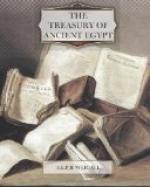It is not often that the finders of antiquities inform the authorities of their good fortune, but when they do so an attempt is made to give them a good reward. A letter from the finder of an inscribed statue, who wished to claim his reward, read as follows: “With all delight I please inform you that on 8th Jan. was found a headless temple of granite sitting on a chair and printed on it.”
I will end this chapter as I began it, in the defence of the Theban thieves. In a place where every yard of ground contains antiquities, and where these antiquities may be so readily converted into golden guineas, can one wonder that every man, woman, and child makes use of his opportunities in this respect to better his fortune? The peasant does not take any interest in the history of mankind, and he cannot be expected to know that in digging out a grave and scattering its contents, through the agency of dealers, over the face of the globe, he loses for ever the facts which the archaeologist is striving so hard to obtain. The scientific excavator does not think the antiquities themselves so valuable as the record of the exact arrangement in which they were found. From such data alone can he obtain his knowledge of the manners and customs of this wonderful people. When two objects are found together, the date of one being known and that of the other unknown, the archaeological value of the find lies in the fact that the former will place the latter in its correct chronological position. But if these two objects are sold separately, the find may perhaps lose its entire significance. The trained archaeologist records every atom of information with which he meets; the native records nothing. And hence, if there is any value at all in the study of the history of mankind, illegal excavation must be stopped.
CHAPTER XI.
THE FLOODING OF LOWER NUBIA.
The country of Lower Nubia lies between the First and Second Cataracts of the Nile. The town of Aswan, once famous as the frontier outpost of Egypt and now renowned as a winter resort for Europeans and Americans, stands some two or three miles below the First Cataract; and two hundred miles southwards, at the foot of the Second Cataract, stands Wady Halfa. About half-way between these two points the little town of Derr nestles amidst its palms; and here the single police-station of the province is situated. Agriculturally the land is extremely barren, for the merest strip of cultivation borders the river, and in many reaches the desert comes down to the water’s edge. The scenery is rugged and often magnificent. As one sails up the Nile the rocky hills on either side group themselves into bold compositions, rising darkly above the palms and acacias reflected in the water. The villages, clustered on the hillsides as though grown like mushrooms in the night, are not different in colour to the ground upon which they are




